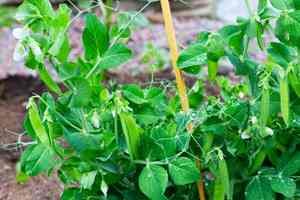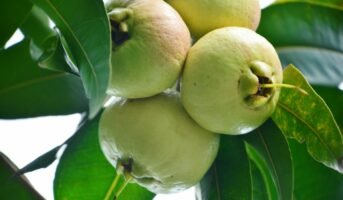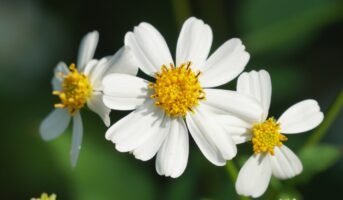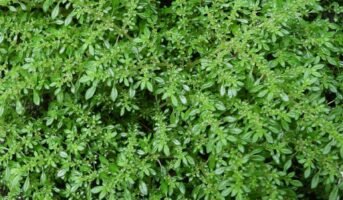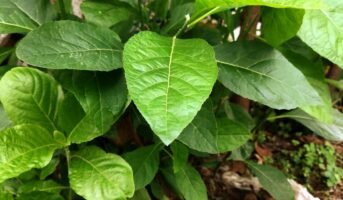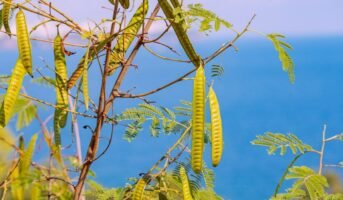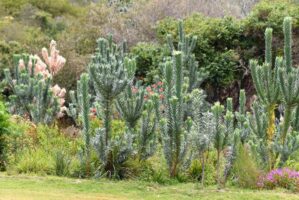The pea plant, the scientific name of which is Pisum Sativum, is a hardy leafy annual plant (any plant that completes its cycle in a single growing season). A pea plant is a climber because its stem is so frail that it cannot stand alone. Its maximum length is 1.8 meters. The stems contain leaves with three pairs of leaflets and have terminal tendrils to aid in climbing. The flowers are formed like butterflies, reddish-purple, pink, or white. The fruit, called legume pods, is four inches long. It splits in half when it is ripe. The pod contains between five and ten seeds. These seeds might be variegated, white, green, yellow, or yellow.
Pea plants are an excellent option because they increase and are simple to take care of. However, they can also be distinguished by several exterior features. For instance, the blossom colour may be white or purple, and the seed produced may be rounded or wrinkled. Pisum sativum is the scientific name of pea plant
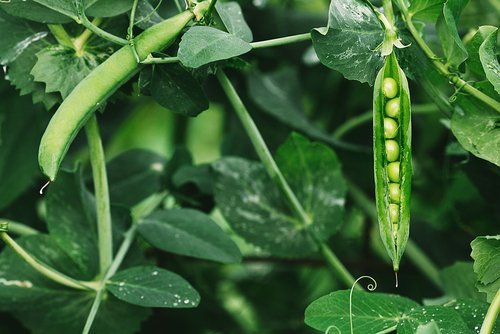
Scientific name of Pea plant
Pisum Sativum is the scientific name of a pea plant. It is a herbaceous annual plant in the Fabaceae family.
Scientific experiments with Pea plants
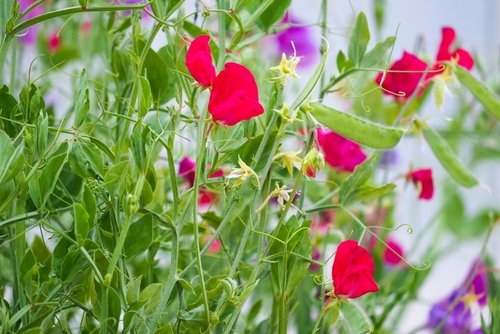
Mendel and his Pea plants
It is common knowledge that parents and children of living things have similar traits. However, it wasn’t released until Gregor Mendel, a scientist, learned how traits are inherited through his research. The “father of genetics,” Gregor Mendel, developed the principles underlying genetics, or the study of heredity.
Blending theory of inheritance
Mendel observed that the plants in his garden did not reflect the parents’ genetic makeup. For example, he kept that two plants, one towering and the other short, developed tall or short offspring but not middle height. So, he decided to try out pea plants. In fact, during the following few years, Mendel conducted experiments on about 30,000 pea plants.
Pea plants: Climatic conditions required for growing
During its growth stage, pea plants prefer a cool climate with an average temperature range of 10–18°C. Germination is hindered when the temperature is below five °C when seeds are planted. Early on in its growth, it can withstand frost. Since it is a crop for the Rabi season, it is sown in the winter.
Local names of green pea in India
Bara Matar (Bengali), Pachai Pattani (Malayalam), Matara (Oriya), Muttar (Hindi), Batani (Kannada), Matar (Marathi), Bhatani (Telugu), Pattani (Tamil).
Pea plants: Health benefits
- It assists in blood sugar regulation.
- It aids with weight loss.
- The development of wrinkles, arthritis, osteoporosis, bronchitis and Alzheimer’s disease are all prevented.
- It strengthens the immune system.
- It might aid in digestion and prevent stomach cancer.
Gardening pea plants
For most homes, gardening is always a fun hobby and a stress relief. In addition, fresh vegetables produced at home are better for your health, provide terrific outdoor exercise, and help you save money on groceries.
The delicious peas you buy in grocery shops in their raw, dry, or frozen forms can not compare to the sweet flavour of exquisite garden-grown peas. They are fresh candies from nature.
The easiest plants to grow are pea plants, and the seeds are an excellent source of protein and nutritional fibre. Their plants produce vibrant flowers, which enhance the beauty of your landscape. It grows only once a year. One can eat all the seeds at once. In the winter, peeling freshly grown peas while the kids assist you and you enjoy the sweet peas can be the perfect, cosiest Sunday afternoon habit.
Pea plants: Varieties
- Sweet peas, also referred to as garden peas or English peas, are a species of pea that is harvested from inedible pods. These characters include Little Marvel, Green Arrow, Thomas Laxton, Lincoln, Wando, and Green Arrow.
- The edible, flat, stringless snow peas pods (P. sativum var. macrocarpon) contain tiny peas. This group includes Sugar Snap, Sugar Ann, Early Snap, and Super Sugar Mel.
- Snap peas (P. sativum var. macrocarpon ser. cv.) are grown for their big, delicious pods. Among them are Mammoth Melting Sugar, Snowbird, and Oregon Sugar Pod.
Commercial-hybrid varieties of green peas in India
In India, hybrid peas are grown commercially under Market, Early Bejar, Bonneville, and Jawahar.
Pea plants: How to grow?
Here’s all you need to know about planting, growing, and harvesting pea plants.

Pea plants: Planting
Peas grow well in well-drained soil and sunny weather.
When to plant peas?
- When the seeds are sown, the soil must be excellent or at the desired temperature, i.e., at least 60°F (but not more than 85°F). It must occur four to six weeks before the final spring frost date.
- Snow will not harm young pea plants, but prolonged periods of cold temperatures may.
- You can plant the second shift of peas in late summer or early fall if they sustain damage.
How to plant peas?
- Peas grow best when directly sown into the soil and dislike disturbing their roots. Transplantation may be done if the container is biodegradable and can be kept in the open field. To hasten germination, you should soak seeds in water for at least an entire night before planting.
- Plant seeds one inch deep, two inches apart, and seven inches apart in rows.
- Peas require phosphate and potassium in their fertilisers. Although legumes must fix nitrogen, an excess of nitrogen may favour the growth of leaves over blooms or pods.
Pea plants: How to grow peas from seeds?
- It is necessary to rinse continuously. The soil needs to remain moist.
- Weeds should be delicately removed with your hands if they threaten the pea plant. Since the roots are so delicate, avoid touching them.
- Heavy sunshine may cause pea plants to turn yellow. During the warmest part of the day, give it shade.
- Suppose the pea plant supplies biodegradable resources like dead leaves, manure, etc. Fertilisers are typically not needed.
Pea plants: How to grow peas in pots?
- Use a piece of plastic screening to cover the drainage hole located at the bottom of the chosen pot.
- Pour potting mix into the container and stop filling 3 inches from the rim. If the potting mix doesn’t have any fertiliser, add an all-purpose formula. Remember that pea plants don’t require much fertiliser. Once done, smoothen the soil in a way that it’s not compacted but relatively flat.
- Soak the pea seeds in water overnight and shake them in a bag with a legume inoculant while they’re still wet before planting them.
- Sow them evenly at least one inch apart. Press them onto the soil’s surface and add 1-2 inches of soil on top of them.
- Water the container deeply.
- Set up a trellis for support as most pea varieties are climbing plants.
- Make sure the soil is moist and well-drained. Also, keep the container in a place where your plants get at least six hours of full sunlight every day.
Pea plants: Harvesting
How do you know when peas are ready to be picked?
Most varieties of peas get quickly mature and are ready to harvest within 60 to 70 days after planting.
- When the tender pods of snow peas begin to open up to show immature seeds, it is time to harvest them.
- Snap peas should be harvested when the pods are plump, full of sweet-tasting peas, and shiny.
- Shell peas should be harvested before the pods start to wax over.
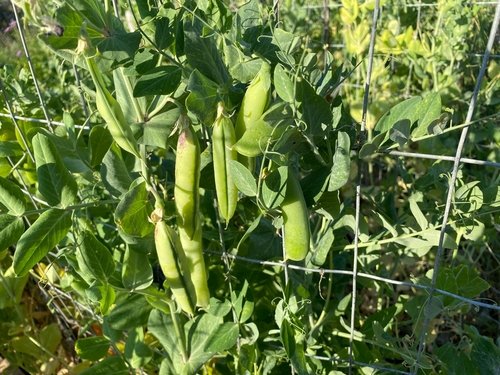
How to harvest peas?
- After the dew has dried in the morning, peas should be collected. Then, they are the crispiest.
- To prevent harming the plant, you should harvest peas with two hands. Hold the vine firmly with one hand while removing the pods with the other.
- Peas have their best flavour right after being harvested.
- To foster the growth of additional pods, harvest frequently.
- The peas can be preserved for use later if you miss the peak season.
How to store peas?
Peas can be stored in refrigerators for five days. If you want to increase the storage duration, keep them in freezers after washing.
Pea plants: Common pests and plant diseases
Some of the common pests and plant diseases that pea plants are susceptible to include:
- Aphids
- Mexican Bean Beetles
- Fusarium Wilt
- Powdery Mildew
- Downy Mildew
- Wireworms
- Root-knot Nematodes
- White Mould
Pea plants: Wit and wisdom
Many believe an extremely ancient green pea plant adage states that if a girl finds nine peas in a pod, the following bachelor she meets will become her spouse.
Pea plants: Uses
- It yields domestically beneficial green and yellow peas. A salad can be made by combining fresh peas with butter, a dash of salt, and a grind of pepper.
- Indian recipes like matar paneer and aloo matar also employ fresh peas.
- Peapods are not very useful for a long time after harvest. Therefore, if it is to be consumed, it needs to be dried or frozen right away.
- The use of fresh peas in non-fire cooking is also possible.
- Also edible are pea tendrils. When the peas are young and 12 to 18 inches out of the ground, they should be harvested. The moment they are harvested, they must be eaten.
- Pea soup is eaten as a traditional dish in certain nations.
- A few delectable peas-based recipes include gingered chicken, snow peas, and carrot; cream of green pea soup; peas and egg fried rice; and green pea walnut pesto.
- The pea plant can be utilised to beautify kitchen gardens by producing vibrant blossoms.
Pea plants: Toxicity
Although garden peas, like English peas, snow peas, and edible podded peas are edible, sweet peas are toxic– especially their seeds and flowers. It’s advisable to keep them away from the reach of children and pets.
FAQs
Is a pea a fruit?
Pea plants produce peas as seeds. They are rich in protein and are mostly consumed fresh and raw, but they are neither a fruit nor a vegetable but a legume.
Do all pea plants need support?
The two types of peas are climbing peas and bush peas. They all need some assistance. Bush peas are just two to three feet tall, but they will flop to the ground if they are not given anything to climb on. The height of climbing peas can range from six to eight feet, and they require robust support, such as a wooden rod.
What do pea plants need to survive?
Pea plants need full sun and soil that drains well to survive. They require less fertilising and can grow well in naturally degraded soil.
How many peas will one plant produce?
Pea plants produce five to six peas in each pod.
Housing News Desk is the news desk of leading online real estate portal, Housing.com. Housing News Desk focuses on a variety of topics such as real estate laws, taxes, current news, property trends, home loans, rentals, décor, green homes, home improvement, etc. The main objective of the news desk, is to cover the real estate sector from the perspective of providing information that is useful to the end-user.
Facebook: https://www.facebook.com/housing.com/
Twitter: https://twitter.com/Housing
Email: [email protected]
